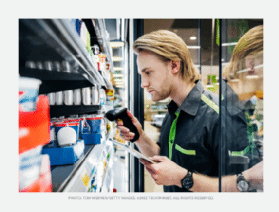Barcode Scanners Introduction
A barcode reader, also called a price scanner or point-of-sale (POS) scanner, is a hand-held or stationary input device used to capture and read information contained in a barcode. A barcode reader comprises a scanner, a decoder (either built-in or external), and a cable used to connect the reader with the computer or POS system. Because erely captures and translates the barcode into numbers and/or letters, the data must be sent to a computer o a software application can translate the data into information. Barcode scanners can be connected to a computer through a serial port, keyboard port or interface device called a wedge. A barcode reader works by directing a beam of light across the barcode and measuring the amount and pattern of the light that is reflected. The scanner converts the light energy into electrical energy, which is then converted into data by the decoder and forwarded to a computer. Barcode readers offer several advantages in retail environments: The most common barcode reader use cases include retail POS systems, inventory management and asset performance management (APM). In retail POS systems, barcode scanners are used to capture product information so that it can be added to the customer's purchase total. Inventory management systems use barcode scanners in supply chain applications to track products from the time they are received into the warehouse until they are shipped out. All these retail applications help businesses keep accurate records of their inventory levels and ensure products are available when customers need them. There are two types of barcode readers: handheld and fixed position. Barcode readers come in many forms depending on their use case: There are a few disadvantages to barcode readers: There are several ways to ensure accurate barcode reads: Barcode readers are a versatile and essential tool for businesses of all types and sizes. With their many advantages, including increased accuracy and efficiency, barcode readers can help businesses improve their bottom line. While there are a few disadvantages to using barcode readers, they can be minimized with proper barcode labelling and tag quality. When used correctly, barcode readers provide an invaluable service to businesses and organizations that need to manage and track inventory and retail goods. If you have any question about barcode scanner , please contact us -- Yanzeo!What is a barcode reader (POS scanner, barcode scanner, price scanner)?
How do barcode readers work?
What are the advantages of barcode readers?
What are some common use cases for barcode readers?
How many types of barcode readers are there?
Are there any disadvantages to using barcode readers?
How can I ensure accurate barcode reads?











